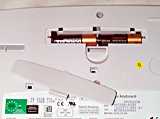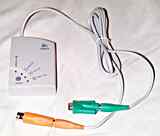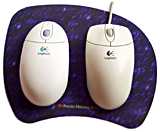
Logitech Cordless Desktop - the untethered keyboard and mouse
Review date: 16 December 1998.
Last modified
03-Dec-2011.
I've got to say, right up front, that mouse and keyboard cables don't bother me. Sure, mouse cables can occasionally snag in the middle of a hectic game, and the keyboard curly cord is one more cable in the mess behind my computer, but really, I'm OK with it. It's not a problem. I'm happy.
If you're not, though, Logitech's Cordless Desktop is for you. For less than $250 (Australian dollars) you get a cordless mouse and a cordless keyboard, and a receiver to plug into your computer. The mouse has a wheel doohickey, the keyboard is a full 104 key job, and they both work up to six feet from the receiver. You don't need line of sight between the peripherals and the receiver - they're radio devices, not infrared. There's even a clip-on wrist rest for the keyboard.
The mouse takes two AAA cells...
...the keyboard two AA.
Yes, the batteries are included.
Setting up
Getting the Cordless Desktop going is simple enough.
The receiver's five foot colour-coded leads terminate in PS/2 connectors, and there are adaptors included for a standard 5 pin DIN connector for the keyboard and a 9 pin serial plug for the mouse. So you should be able to hook up the receiver to any IBM compatible.
Once the receiver's plugged in, just power up the computer and you're away. The Cordless Desktop package comes with special software that provides System Tray icons for Caps Lock and Num Lock and Scroll Lock (there are no LEDs on the keyboard, to save power), but the lights are duplicated on the receiver, so you don't really need them.
The keyboard, mouse and receiver all have little communication buttons which let you stimulate them to connect with each other if there's a problem. In conjunction with the included software, the buttons let you be absolutely sure if the receiver can't see the mouse or keyboard. But you shouldn't need to fiddle with the buttons - it should all just work.
The software also pops up a box to warn you when the mouse or keyboard batteries are getting low. If you don't run the software, there's only a flashing light on the receiver to alert you to flat batteries. Which brings us to a simple question:
How long do they last?
Pretty much the first thing that springs to mind when you're shopping for battery powered peripherals is how long the batteries can be expected to last. According to the back of the box, the batteries should last "from six months to a year", but I hooked up the multimeter and checked just the same.
The keyboard consumes about seven milliamps when you're typing, and, so far as I could measure, no current at all when when it's just sitting there. Given that the two alkaline cells that power it are good for about 2400 milliamp hours, you can hammer away constantly for a fortnight without sleep before you have to replace the batteries. Since you're not likely to be using the keyboard anything like 24 hours a day - any time you're not typing, even for a second, is time when the keyboard's not consuming power - I wouldn't be surprised if its batteries lasted a year or more in home use.
The mouse consumes 10 milliamps while you're moving it around and clicking buttons, and barely one milliamp when you stop moving it. After a few minutes it goes into a stand-by mode in which it consumes only about a twentieth of a milliamp. The little AAA cells it takes have a capacity of about 1100 milliamp hours, so in constant use they're good for only about four and a half days. Again, though, given the fact that the mouse doesn't use full power when it doesn't need to, I think a lifespan of three months or so would be quite likely. "Six months to a year" is, I think, overly optimistic.
Trying it out
Something I've become acutely aware of since I got a USB mouse is sampling rate. Ordinary PS/2 and serial mouses under Windows 95/98 run, by default, at a sampling rate of 33Hz. That is, the cursor location is updated only 33 times per second. You may think that sounds like plenty, but when you switch to a 100Hz USB mouse the difference in feel is startling. You suddenly see why Macintosh users say "Eew!" whenever they use Windows. Well, you see one of the reasons, anyway.
The Logitech cordless mouse has a sampling rate of 50Hz. I know, because I used Mouserate (available here) to find out. You can tweak the sample rate of PS/2 mouses with programs like PS2Rate (available here), and I tried it on the Logitech; I could set the rate lower, but not higher. 50Hz is all the cordless mouse can manage.
Does this matter? No, not much. If you're a rabid gamer or spoiled by a higher rate mouse, you won't like 50Hz much. But it's better than 33Hz.
I used the Cordless Desktop for a couple of days of hectic typing, and found it OK. Not great, but OK. The cordless mouse's 50Hz update rate is acceptable, and it's fairly comfortable - not, I think, as comfortable as my regular Logitech USB mouse, but OK. The battery compartment makes the back of the mouse bulge out, but whenever you change to a new kind of mouse it feels weird for a couple of days. I could get used to it.
The keyboard was less tolerable. I do a lot of typing, and so a keyboard with lousy feel is annoying to me. The Cordless Desktop keyboard is about as bad as the cheap $20 keyboards that come with bargain basement clones. Every now and then I'd fail to completely depress a key and miss a letter - which, at first, I thought was a problem with the radio link - and the larger keys have a wobbly feel. The cordless keyboard also has Windows keys, which many people loathe because they keep hitting them when they want Alt or Ctrl.
If you're a serious typist, a keyboard like this will get on your nerves. Most users, though, won't care. The Logitech keyboard seems solidly enough constructed, it just feels a bit dodgy to me. I was glad to go back to my faithful Honeywell.
Incidentally, the cordless keyboard has a stern message indelibly printed above the cursor keys: "WARNING: Some experts believe that the use of any keyboard may cause serious injury. Consult statement on back of this keyboard." It also comes with a multi-language booklet on keyboard ergonomics. Given that this keyboard encourages you to use it in your lap or in bed or who knows where else, these ergonomic warnings may be ignored. But don't say Logitech didn't warn you.
The cordless mouse has a similar footprint to its corded sibling...
...but in profile its bulbous rump is obvious.
Overall
You can get a corded keyboard that feels no worse than the Logitech for $30 (Australian dollars). And a regular Logitech wheelie-mouse will set you back no more than about $50. So, at a shade under $250, the Cordless Desktop carries a big price premium for its cordless convenience.
If your mouse and keyboard cables are causing you more than $150 worth of annoyment, check the Cordless Desktop out.
Pros: |
Cons: |
|
|







